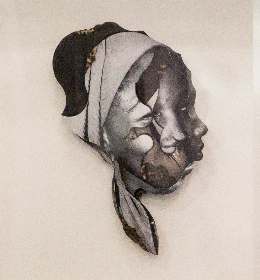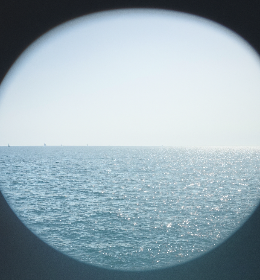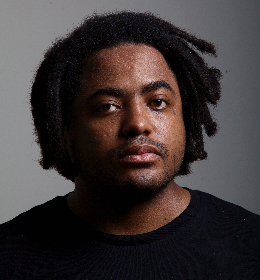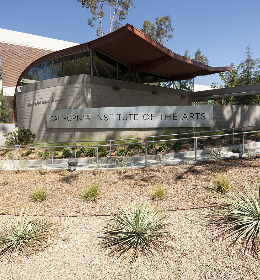I’ve been curating in the gallery space for the past 8 years, and curated other shows in Macau, Shanghai and Lisbon since then. After three years in Lisbon, I had the opportunity to go back to Asia, where I was appointed Director of Development of a newly opened contemporary art foundation in Hong Kong. I was working closely with an American curator, taking care of fundraising and seeking sponsorship through the friends of the foundation program; working on anything that would help carry our program. This is where I realized the importance of curators and the institutions they work for. The very important mission they carry to link the artists and their work with the public.”

An exhibition map used to navigate the exhibition through clicking on individual points on the map
This new platform, Art Curator Grid, has become especially significant this year during the pandemic, when so many art and cultural institutions have been closed. On top of that many conferences, where curators and arts administrators would normally have the chance to meet each other and network, have been canceled or postponed until 2022. In the meantime, curators now have free access to sign up and begin planning and proposing ideas to institutions for future projects, connect with other curators and bolster efforts to strategize for the post pandemic world through this art tech content management system, Art Curator Grid.
As a curator and artist myself, I decided to experiment with the grid and have curated an exhibition of the work of artist Zsolt Asztalos, who represented Hungary at the Venice Biennale in 2013. The exhibition is entitled,Zsolt Asztalos: The Canon of Remembrance or The Remembrance Canon and includes a triangulation of artworks demonstrating the underlying patterns of thought and developing research he has focused on for the past several years culminating in his distinctively quiet, yet groundbreaking work, in relation to memory building in the private and public sphere, through art and objects.
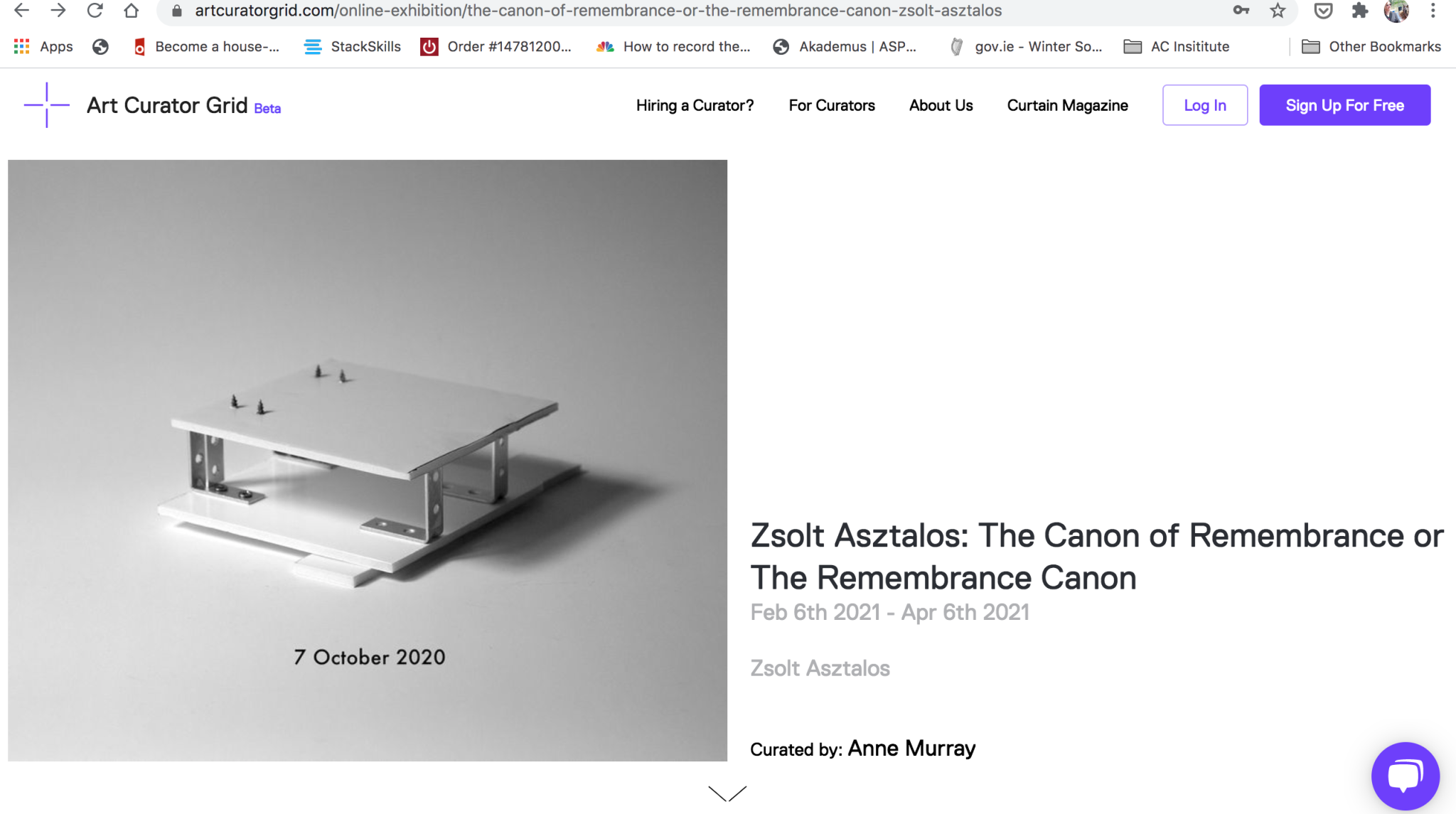
I found that the grid enables one to create online exhibitions for the public as well as to privately share with institutions or other curators as a digital representation that could be an end in itself or a means to suggest the possibilities for a physical exhibition in the future. In a time of pandemic this facilitates the production of online exhibitions to go with physical shows that might be closed or open only for part-time visiting hours. It also enables collaborative projects where one can see a draft of an exhibition and exchange ideas before it becomes public. There are options to include video, links, photos, text, curatorial statements and information points as well as a clear list of works and images once they are entered onto points on an exhibition map; this image can end up being much like a subway map with various points for each art work that can be navigated and clicked on to obtain further information about the works.
Foessel writes in an email response to my questions about the development of this art tech content system, “I was always interested in what was happening digitally in the art world, I was following the key players that were making a difference but it was mainly in the art market, no global platform in the institutional world stood out. I also felt that we (art professionals) were all using social media, but I was feeling a gap between what we would need and what these existing platforms were offering.”

Curators Conversation-Women Curators Discussing Women in the Arts on ZOOM, in partnership with ASSEMBLY ROOM NY
I have to agree with Foessel’s statement. Prior to Art Curator Grid hitting the market, there did not seem to be any platform like this that could facilitate exchanges between curators and institutions as to concisely present ideas and images in a clean system.
Foessel shares some of her philosophy, “I believe that, in our curatorial mission, texts are as important as the photographs online, which is why I thought about starting a professional platform centered around the work of curators, with a goal to also help institutions in their endeavor.” The platform will enable curators to be in contact with one another and collaborate on projects, which they can propose to institutions as well as galleries, and municipal projects. Foessel writes, “Our will, for the art market, and the art world in general is to create more connection between the different actors. Artists build their career, galleries represent them, curators select artists for their exhibitions in the institutions.”
The platform is accessible to anyone, but the main focus is on curators as the activators as well as the museums and artists. Initially they are building this network with curators and have over 600 on the platform, and will later create a subscription base for the institutions to participate, eventually also adding the artists to the mix. The Head of Communications at Art Curator Grid is Aude Quinchon, who worked in Shanghai as well and is well versed in the international art market. Foessel explains their connection, “I met Aude back in the days in Shanghai, I was the gallery manager of a newly opened art gallery, I was in a gap year of my master’s degree, I was meant to stay a year and Aude came to replace me. After that, we stayed in touch, I returned later so we already worked together in the past. 10 years passed by as we followed each other’s path and when I was looking for a great head of communications for the platform, I remembered that Aude was an expert at this.”
“The main concept of the platform is to serve all the parts of the art-world ecosystem, focusing on the curators as the maestros of the art world,” Foessel iterates. “The platform is already in first place in terms of the way it connects through its ‘grid’ the different important roles in the art world and art market.” She stressed the importance of institutions, “Obviously, institutions will play a vital role here as they’ve always been a key link in the relationship between curators and artists. Galleries and Institutions will have their profile page on Art Curator Grid, they will be able to use our paid tools as well, our exhibition tool for example will be directed to them. We are creating these tools to give a digital continuity to institutions public programs, to enrich their offerings and gain more audience. With the exhibition tool, especially, we wish institutions and galleries, if they wish to connect with a curator, to connect with the right one. Our exhibition tool gives a visual representation of the curatorial concept and it allows the curators to add content to the exhibitions or artworks (interviews, studio visits, research documents or anything they wish to offer to their public). It is a new way to offer content structured online for an exhibition.”
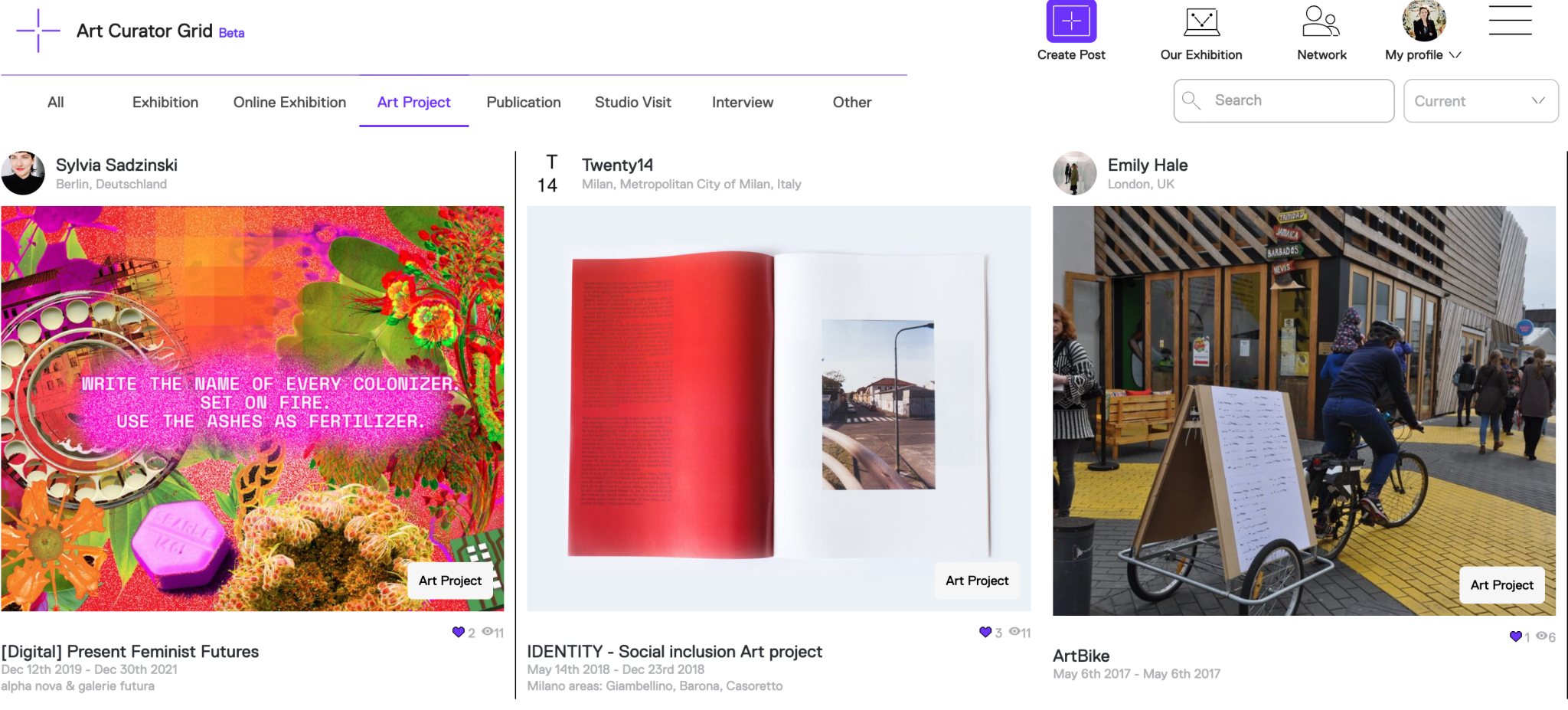
Screenshots from Art Curator Grid platform
I asked Foessel how this new platform might influence and offer new insights and ways of marketing, she described in detail, “The change we are wishing to bring is more in the institutional world. The impact and power of museums, art centers, foundations, artist run spaces and nonprofits is incredible. These challenges are social, cultural, educational. I wish for us to bring tools that reflect the issues they are facing today, and this is everywhere: accompany them in their digital change with an exhibition tool that responds to their needs in terms of cost, effectiveness, and a new way to reach their audiences with the possibility to have a simple exhibition map hosting many different kinds of content in addition to the artworks.”
Foessel’s explanation is succinct and poignant, indeed, there is so much potential for this platform to aid in a more connected network of institutions, curators, and artists as well as to accompany the public through the online exhibitions. One might even say that these types of platforms might eventually replace museums…
Foessel emphasizes, “I believe the strength of a strong network of curators and institutions is important for the other actors of the art market. Galleries are hiring more and more curators to work on their shows; the work of a gallery is ultimately working alongside the institution to have their artists present in their shows. Collectors also are looking for the artists selected in shows by curators. I believe everything is interlinked, and we are relevant for any actors of the art world, however our main focus is on the institutional world.” I look forward to seeing how this impact defines itself and multiplies in a grid of different possibilities on multiple plains.





